
Economic Affairs, Vol. 65, No. 4, pp. 619-625, December 2020
DOI: 10.46852/0424-2513.4.2020.18

Research Paper
Supply-Demand Projection and Gap Analysis for Major Pulses in Assam
ABSTRACT
Pulses are important constituent in the food basket of people of Assam. The state produces 107.5 thousand tonnes of total pulse from an area of 146.4 thousand hectare with yield rate of 735kg/ha (2016-17). The present production is able to meet only 20 per cent of the present requirement. The major pulses grown in the state are gram, arhar, greengram, lentil, blackgram and pea. A study conducted with the objective of analysing the supply demand gap of pulses in Assam, it was found that there was huge gap in requirement and supply of most of the pulses except black gram and pea and the deficit continues upto 2025, as well. The government has been trying to increase the pulses production with increase area and enhanced yield through various schemes namely NFSM-Pulse. Bringing more pulse area under irrigation, adoption of recommended production technology is expected to increase the yield that might help in bridging the demand supply gap. As blackgram was found to be surplus, the people of Assam should gradually replace lentil with blackgram as dal. Establishment of mini dal processing plant might attract the youth to grow and process pulse and thereby increase the employment opportunity and enhanced production in the state.
Highlights
 Most of the pulses are deficit in production than requirement except blackgram and pea.
Most of the pulses are deficit in production than requirement except blackgram and pea.
 Pulses area, production and yield are increasing.
Pulses area, production and yield are increasing.
 Pulses development programme are fruitful in the state.
Pulses development programme are fruitful in the state.
 Consumption of pulse per person per day is less than ICMR recommendation.
Consumption of pulse per person per day is less than ICMR recommendation.
 Increasing area under rabi pulses with adoption of appropriate technology will help to enhance the yield and reduce the gap between supply and demand.
Increasing area under rabi pulses with adoption of appropriate technology will help to enhance the yield and reduce the gap between supply and demand.
Keywords: Supply, demand, gap, pulses, irrigation, Assam
Pulses are an integral part of sustainable agriculture because of their vital role in nutritional security and soil ameliorative properties (Kumar et al. 2011). Pulses are comparatively cheap sources of plant protein. Pulses are an important group of field crops that provide good quality protein complementing cereal proteins for principally vegetarian population. They can be cultivated in various cropping systems without disturbing the main crops in the rotation. They contribute significantly to the nutritional security of the country due to high nutritional value (20-30% protein) (Srivastava et al. 2010). Roy and Bhattacharyya (2018) found that total food grains production will be increased to 281.12 Mt in the year 2020 as well as the population will be 1345 million. The demand-supply scenarios present an alarming situation at present especially for pulses. The demand-supply gap for pulses is going to more adverse condition which strongly affects our food and nutritional security. Demand of pluses in 2020 will be 22.92 Mt whereas the pulses supply in that year will be 19.68 Mt. So, it is confirmed that the demand-supply gap of pulses goes in negative. Pulses are important food item after rice for the people of Assam consumed as dal. The major pulses grown in Assam are black gram, green gram, linseed, lentil, peas, beans etc. Assam's share India's pulses production is very negligible. The average yield of most of the pulses in the state is marginally lower than the national average. Area of pulses in Assam is reported to be 146.6 thousand hectare that supplies a production of 107.5 thousand tonnes with yield level of 735 kg/hectare in 2016–17. In Assam, pulses are cultivated in both kharif and rabi season, though rabi season accounts for higher share of total pulses produced. Nearly 94 per cent of total pulses cropped area comes under rabi pulses in the state. The production of pulse in the state is nearly 108 thousand tonnes during 2016–17 which can meet only 20–25 per cent of the requirement. A huge amount of pulses has to be imported from other states of India to Assam annually. Increase in demand caused by short supply results in high price of pulses and the poor income households cannot afford to have pulse which affects their human productivity. The department of agriculture has planned for increase in area under pulses in the state with high yielding varieties. Of late National Food security Mission- Pulses has been implemented in the state that is contributing to both area and yield increase. Assam, one of the seven North Eastern states of India, was awarded Krishi Karman award for the best performing state in pulse production by Ministry of Agriculture, Government of India in 2013–14.
How to cite this article: Barman, N., Hazarika, J.P., Talukdar, U. and Deka, N. (2020). Supply-Demand Projection and Gap Analysis for Major Pulses in Assam. Economic Affairs, 65(4): 619–625.
Source of Support: None; Conflict of Interest: None 
However, with increase in population the demand for pulses has also been increasing in the state. Minimum requirement of pulses as recommended by Indian Council of Medical Research per person per day is 40g. where as, average consumption of pulse in Assam is only 23g/person/day which is much lower than the recommendation (NSS, 2013–14).
Hence, an attempt has been made in this paper to estimate the demand for and supply of major pulses up to year 2025 for Assam. These projections are likely to help in devising an optimum land use pattern and in setting appropriate production targets.
MATERIALS AND METHODS
The present study was based on secondary data obtained from various Government publications and reports. The data on area, production and productivity and other related variables of pulses of Assam were collected from different published sources. The data on consumer expenditure on pulses for consumers were compiled from 68th round of National Sample Survey (NSS, 2011–12). The population data of Assam as of 2011 census were collected, and the population were projected to the year 2025. The total production of each pulse was projected up to the year 2025, which would also serve as the projected supply of pulses. The data on per capita Net State Domestic Product (NSDP) at constant price of 2011–12 was collected from Directorate of Economics and Statistics and this was used for the estimation of income growth.
ANALYTICAL TECHNIQUES
Growth in area under major pulses and growth in income
Growth rates for area, production and productivity of six pulses and per capita net state domestic product (NSDP) were computed using exponential growth model and the compound growth rate, CGR (%) was obtained by fitting the following equation
Y = abt
ln Y = ln a + t ln b
Where, Y = area/ production/ yield of the pulses and NSDP
a = constant, t = time period and b = coefficient to be estimated
Then CGR (%) was obtained as follows r = {Antilog(h)-1} × 100
The significance of ‘r’ was tested by working out t-value,
‘t’ = b/SE(b).
Where, ‘t’ follows student's t- distribution with (n-2) degrees of freedom.
The growth of NSDP was taken as proxy for income growth in Assam.
The instability in area, production and yield of pulses for the reference years was examined by the coefficient of variation and calculated as:
CV=SD/mean * 100
Where, SD = standard deviation of area, production and yield of different pulses, Mean = average of A/P/Y of different pulses
Estimation of demand
The future demand for pulses is estimated by the following formula,
Qit = Pt {qi0 (1 + g).ne it}
Qit = Quantity demanded of the commodity; Pt = Projected adult population where,
Pt = PQ (1+ r)t
P0 = base period adult population; r = Population growth rate; t = number of years; qi0 = Base period consumption of the pulse; g = Growth rate of per capita NSDP; n = number of years; eit = expenditure elasticity
Estimation of supply
The supply is estimated by the formula,
St = S0 (1 + r)t
St = Supply to be estimated; S0 = Supply or production of the base year; r = Growth rate of production; t = time period
Expenditure Elasticity of Demand
Logarithmic form is used to estimate the expenditure elasticity of demand for different pulses. The expenditure elasticity was calculated by using NSS data from the 70th round (2013-14).
Qi = aEbit
ln Qi =lna + b InEit
Qi = quantity of pulse consumed by ith household; E.t = total consumption expenditure of the ith household at time period t; a = intercept, and b = coefficient
The elasticity thus obtained was used for demand projections with the assumptions that the consumer expenditure is insensitive to price changes and the expenditure elasticities do not change over time or with price.
The study has referred the data for the period from 2007–08 to 2015–16. The secondary data on different pulses for Assam are available upto 2015–16 only. The projection of supply and demand is made for another 5 years (2025) as mere projection for a longer time may not be justified.
RESULTS AND DISCUSSION
Growth performance of pulses in Assam
The compound growth rate of area under all pulses except Arhar was found to be positively significant showing that there was increase in area under pulses in the state. Similarly, for production and yield also, the compound growth rates were found to be significant and positive for all the six pulses depicting that production and yield had significantly increased for these pulses in the state. Increases in area and yield were contributing to higher production of pulses. Implementation of National Food Security Mission (NFSM) for pulse in the state from the year 2010 contributed to both increase in area and yield. Adoption of improved variety over the traditional variety along with better management practices was also responsible for increased yield. There was considerable instability in area, production and yield of all the pulses in the state which might be due to less area and low yield during initial period and increased area and higher yield in the later period (Table 1).
There was an increase of area and yield during 2007-08 from 113 thousand hectare and 558kg/ha to 142 thousand hectare and 757 kg/ha during 201516. Narayan and Kumar (2015) have conducted a study on constraints of growth in area production and productivity of pulses in India, and found that the growth rate of pulses area and production were found negligible as compared to cereal like wheat and paddy and there exist wide inter states variability in their yield in the country. Occurrence of frequent and unpredictable floods and lack of easy credit facilities are some other factors for low yield. Constraint analysis revealed that the state's production is limited by high rainfall during Kharif season especially July to September months resulting in wide spread flood that affects pulses adversely (Praharaj et al. 2018).
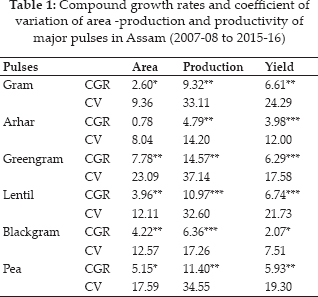
Projected supply for major pulses of Assam
The projected supply of different pulses based on the present production of the pulses is presented in Table 2. It was found from the table that pea recorded the highest supply with 60.36 thousand tonnes followed by black gram with 55.74 thousand tonnes, while gram recorded a supply of 3.15 thousand tonnes in 2024–25. The pulses development programme under NFSM-Pulse and seed village programme are expected to contribute to the enhanced production of major pulses during next five years in the state. The department of agriculture, govt of Assam has projected to have a production of 3.90 lakh metric tonnes of pulses with an enhanced yield of 1200 kg/ ha during 2025 (Agri Vision 2025) that can reduce the deficit to a18 per cent.
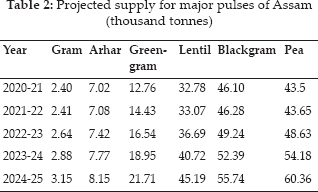
Per capita income growth
Per capita income growth was estimated using time series data of per capita state net domestic product of Assam for the year 2007–08 to 2015–16 at constant price of 2011–12. The growth in per capita income in the state was found to be 6.10 per cent which was highly significant depicting that per capita income at the state is increasing at significant rate (Table 3).

The expenditure elasticities of major pulses were estimated and presented in the following table (Table 4). The present study uses Engel curves with double log function fitted to major pulses crops. The dependant variable was the expenditure share of each pulse. The independent variable of the equation included the total household expenditure. The advantage of Engel curve is that it takes into account income (expenditure as proxy), an important determinant of consumption pattern (Jadhav et al. 2018).
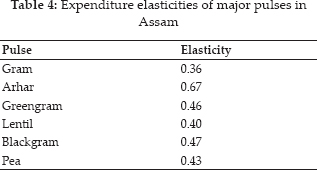
Projected adult population and demand for major pulses in Assam
Population projection was made to estimate the demand for different pulses in Assam. The population data for the state published by the census of India for the years 2001 and 2011 was used to project the total population of the state upto 2025. The pulse demand projections are derived using estimated growth in population and income. The income (expenditure) elasticities derived from the functional forms for different pulse items are considered to forecast the demand for different pulse. It was found that by 2025, the population of Assam would be 3060757 3 and the demand for gram, arhar, greengram, lentil, blackgram and pea would be 15.16, 20.87, 85.94, 200.53, 20.47 and 8.97 thousand tonnes (Table 5). Several researchers have done study on demand projections for various food items in India (Kumar, 1998; Mittal, 2010 Chand, 2007; Kumar et al. 2009).
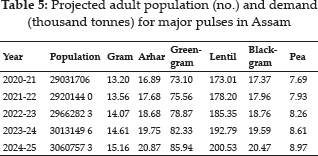
Supply and Demand Gap Analysis for Major Pulses
The supply for major pulses was estimated as the production of those pulses. The demand was estimated based on expenditure elasticity and projected population. The difference between supply and demand was estimated as the gap analysis of major pulses for the state. This gap analysis throws light in the direction to be taken for increasing the production of the pulses so as to achieve self sufficiency. The supply was gradually increasing due to increase in area under pulses coupled with technology, weather and productivity. On the other hand, due to growth in population and per capita income demand for pulses increased over the years. The gap analysis revealed that the supply is more than the demand in the case of blackgram and pea. However, the demand for gram, arhar, greengram and lentil exceeds the available supply showing heavy deficit of these pulses in the food basket at present and during 2025 as well (Table 6, Fig. 1).
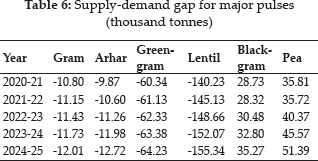
Jadhav et al. (2018) have conducted a study on supply-demand gap analysis and projection for major pulses in India and found that there is a big gap between supply and demand of major pulses in India, suggesting a shortage of pulses for domestic consumption. Mittal (2008) had conducted a study on demand and supply trends and projection of food in India. The study found that an increase in total demand is mainly due to growth in population and per capita income. The post harvest loss of pulses was reported to be 7.84 per cent of the production due to loss at different stages in Assam. Improving infrastructure facility and adopting superior farming technique and tools could minimize the post-harvest losses to a minimum level (Dutta et al. 2018).
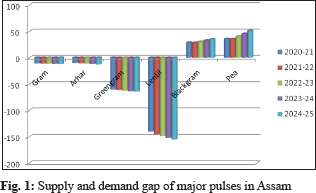
Efforts to minimize yield gap can be an important viable strategy to increase productivity and production of pulses. Non-monetary inputs, including improved agronomic practices, such as timely availability of all inputs and their application in the fields, timely sowing, pest management practices, regular mechanical weeding, timely harvesting and post-harvest handling also could help increase pulse production (Roy et al. 2017).
Pulse development strategies in the state
Unless the yield is increased, mere increase in area under pulses might not be able to bridge the gap between supply and demand. On the part of Assam Agricultural University, several technologies along with improved variety of pulse have been developed. Recently, 3 greengram, 6 blackgram and 2 lentil varieties are developed at the university with high yield potential. The char area along the riverside is envisioned to cover by pulses under the Krishi Vigyan Kendra's of the university to increase production. Government of Assam has initiated measures for pulse development such as NFSM-Pulse, increase of area under rabi pulse by another 1.75 lakh hectares by 2025–26, increase of productivity from the present level of 600 kg/ha to 1200 kg/ha by 2025–26, increase of area under arahar (Pigeon Pea) during kharif, popularization of modern pulse production technology like improved seeds and use of bio-fertilizers, introduction of rabi pulse as intermediate crop under irrigated ecology etc. In 2010–11, in addition to above mentioned schemes, two new programmes relating to bringing green revolution to Eastern India and integrated development of 60000 Pulses and Oil seeds Villages in rainfed areas have been initiated under RKVY.
CONCLUSION
From the study it was inferred that despite of gradual increase in the area and yield of pulses in the state, a huge gap exists between the supply and demand of pulses. Most of the pulses production is much below than the requirement. Both agricultural department and Assam Agricultural University are initiating actions for pulse development in the state that might contribute to increase production and reduce the deficit. There is an urgent need to increase the production of pulses if the demand of the State's population is to be met by its own production. The area under kharif and rabi pulses in the state was 6.1 and 142.2 thousand tonnes (2014-15). While, the rabi pulses have to be grown under irrigated condition, however, the area under irrigated pulse (rabi) is only 1995 hectare which is only 1.40 per cent (2014-15). This low irrigation percentage is one of the main reasons for low productivity of pulse in the state. Further, low or no adoption of recommended technology such as plant protection chemicals, mechanization, improved variety etc are some of the contributing factor to low yield. Measures should be taken so that the growers adopt these technologies for better yield and production to support the demand. Identification of ideal areas is needed where pulse productivity and acreage can be increased with cost effective technology and management practices. The rice fallow area of the state should be covered by different types of short duration non-lodging pulses varieties. Supply of electricity for critical irrigation at the critical period of crop growth, credit support and all such vital input aspects may be properly addressed in an institutionalized manner. Setting up of mini dal processing plants at community level through marginal, small and medium enterprise (MSME) scheme might reduce post harvest loss, create employment opportunity and attract the youths to cultivate more pulses in the fallow area which indirectly can contribute to bridge the gap between demand and supply in the state. Further, it would be recommended that as balckgram production is surplus, consumption of lentil as dal has to be replaced by blackgram. A concerted effort on the part of the stakeholders is expected to increase the pulse production in the state to meet the required demand.
REFERENCES
Agri Vision 2025 in Assam Vision 2025. Published by Directorate of Agriculture, Government of Assam.
Chand, R. 2007. Demand for Foodgrain. Economic and Political weekly 10–13. 5. Commodity profile for pulses.
Dutta, P., Baruah, A. and Deka, N. 2018. A Study on Post Harvest Losses in Pulses in Nagaon District of Assam. Indian Journal of Economics and Development, 14(1), 191–194
Impact of Technologies on Pulses Production in North Eastern Region (2018) edited by B.C. Deka, Divya Parisa, A.K. Singha Daegal A. Massar and Rupaia Siangshai. Published by ICAR-Agricultural Technology Application Research Institute (ATARI), Umiam, Meghalaya.
Jadhav, V., Mallikarjun Swamy, N. and Gracy, C.P. 2018. Supply-Demand Gap Analysis and Projection for Major Pulses in India. Economic Affairs, 63(1) 277–285.
Kumar, P. 1998. Food Demand and Supply Projection for India, Agricultural Economics policy paper -98-01. Indian Agricultural Research Institute, New Delhi.
Kumar, P., Joshi, P.K. and Pratap, S. Birthal. 2009. Demand projection for food grains in India, Agriculture Economic Research Review, 22(2): 237–243.
Kumar, S., Bourai, V.A. and Kumar, H. 2011. Post-harvest losses in pulses of Uttrakhand: A specific study of sample villages of Asian valley. Economic Affairs, 56(2): 241-245.
Surabhi, M. 2010. Demand and supply trends and projection of food in India, working paper No 209, ICRIEP,
Narayan, P. and Kumar, S. 2015. Constraints of growth in area production and productivity of pulses in India: An analytical approach to major pulses. Indian J. Agric. Res. , 49(2): 114–124.
Praharaj, C.S., Singh, N.P. and Singh, U. 2018. Up scaling Pulses Production in Constrained NEH Region of India, Conference paper, 7th International Food legume Research Conclave,
Roy, A., Singh, N.U., Tripathi, A.K., Yumnam, A., Sinha, P.K., Kumar, B. and Das, S.K. 2017. Dynamics of Pulse Production in North-East Region of India- A State-wise Analysis. Economic Affairs, 62(4) 655–662.
Roy and Bhattacharyya. 2018. Statistical Investigation of Food Grains Demand aand Supply in India. International Journal of Agriculture Sciences, 10(11): 6200–6205.
Srivastava, S.K., Sivaramane, N. and Mathur, V.C. 2010. Diagnosis of Pulses Performance of India. Agricultural Economics Research Review, 23: 137–148.